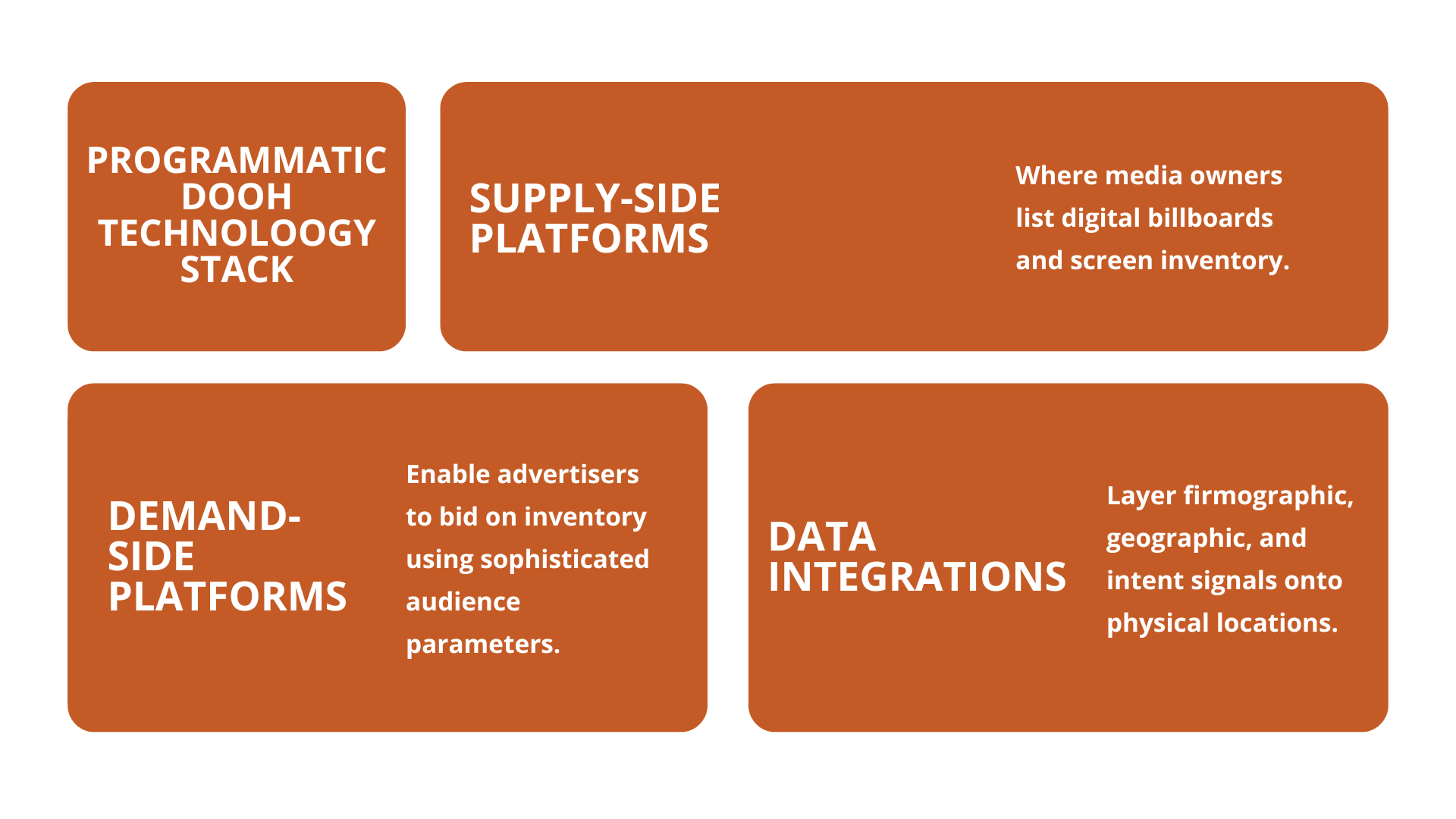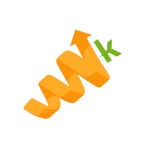How Programmatic DOOH B2B Reaches Decision-Makers Anywhere
Picture this: your ideal B2B prospects are commuting through Grand Central Station, waiting at O’Hare Airport, or grabbing coffee in a downtown corporate plaza. Traditional digital ads can’t reach them at these moments. However, programmatic DOOH B2B campaigns can, and they’re delivering measurable results that directly tie to pipeline growth.
Digital out-of-home advertising captured 34% of total U.S. out-of-home ad spend in 2024, reflecting a 7.5% year-over-year increase, according to the Out of Home Advertising Association of America. More importantly for B2B marketers, programmatic DOOH campaigns that combined Hivestack’s DSP with Bombora’s B2B intent data delivered an 11.2% lift in online research intent among targeted business audiences.
What makes programmatic DOOH B2B such a groundbreaking tactic? Programmatic DOOH advertising is more data-driven, allowing advertisers to capture custom audiences. This isn’t just another advertising channel; it’s a strategic weapon for reaching decision-makers in high-value contexts where your message can’t be blocked, skipped, or ignored.
Key Takeaways
- Programmatic DOOH B2B campaigns deliver measurable pipeline impact with 34% of total U.S. out-of-home ad spend now digital and campaigns achieving an 11.2% lift in online research intent when combined with B2B intent data.
- Layer firmographic data with geofencing for surgical precision targeting by creating zones around corporate campuses and business districts where your ideal customers work rather than using generic demographic targeting.
- Use contextual triggers and dynamic creative optimization to adapt messages in real-time based on weather, stock market conditions, flight arrivals, or event attendance for maximum relevance and engagement.
- Integrate B2B intent data to activate screens near high-intent companies by combining platforms like Bombora’s intent signals with location data to reach prospects actively researching your solutions.
- Establish attribution frameworks before launch to measure true ROI by tracking intent lift, cross-device engagement, and pipeline influence rather than just impressions or basic awareness metrics.
TABLE OF CONTENTS:
Understanding Programmatic DOOH B2B Fundamentals
Programmatic digital out-of-home (pDOOH) transforms traditional billboard advertising into a data-driven, automated buying experience. Unlike static outdoor ads, programmatic DOOH B2B campaigns utilize machine learning to execute real-time bidding, audience intelligence, and contextual triggers, serving the right message to business professionals at the best moment. These campaigns automate every essential process: buying, planning, selling, targeting, delivering ads, and measuring results.

The technology stack consists of three critical components:
- Supply-side platforms (SSPs) where media owners list digital billboards and screen inventory.
- Demand-side platforms (DSPs) that enable advertisers to bid on inventory using sophisticated audience parameters.
- Data integrations that layer firmographic, geographic, and intent signals onto physical locations.
What makes this particularly powerful for B2B marketers is the ability to combine location intelligence with business intent data. When a company shows high research activity for “cybersecurity solutions” in Bombora’s intent data, you can trigger ads on screens near their office building, creating a perfectly timed touchpoint in their buyer journey.
Targeting Strategies That Drive B2B Results
The most successful programmatic DOOH B2B campaigns go beyond basic demographics to leverage these sophisticated targeting approaches.
Firmographic Geofencing for Precision
Savvy B2B marketers create geofenced zones around corporate campuses, technology parks, and business districts where their ideal customers are working. This isn’t random targeting; geofencing is a strategy that delivers relevant ads based on company size, industry vertical, and job function data.
Captivate’s programmatic DOOH campaigns in elevator and lobby screens demonstrate this approach perfectly. After layering firmographic data (industry, job title, company size, named accounts) with ABM strategies, they helped B2B advertisers reach decision-makers exactly where they make purchase decisions — inside the workplace.
Contextual Triggers for Message Relevance
Dynamic creative optimization (DCO) takes programmatic DOOH B2B campaigns to the next level by adapting messages in real time based on external data feeds. Consider these powerful triggers:
| Trigger Type | B2B Application | Example Message |
|---|---|---|
| Weather-based | Cloud services during storms | “When systems go down, we keep you up” |
| Stock market | Financial solutions during volatility | “Navigate uncertainty with real-time insights” |
| Event-driven | Conference attendee targeting | “Saw our booth at TechCrunch? Let’s talk ROI” |
| Flight arrivals | International business travelers | “Welcome to NYC – Scale globally with us” |
Ria Money Transfer’s campaign with JCDecaux and Displayce showcases contextual excellence. They utilized live flight data to trigger programmatic DOOH ads at Brussels Airport only when flights from seven target countries landed, resulting in 1.3 million highly relevant impressions and a 2.8 times cost-efficiency gain over traditional DOOH.
Intent-Driven Activation With B2B Data
The most sophisticated programmatic DOOH B2B campaigns integrate intent data platforms, such as Bombora, to identify companies actively researching specific solutions. When combined with location data, this creates exact targeting opportunities.
“Pairing high-fidelity intent data with programmatic DOOH unlocks account-level precision and closed-loop ROI measurement for B2B advertisers,” according to Bombora’s recognition as a Leader in Forrester’s 2025 Wave for B2B Intent Data.
This approach allows you to activate screens near companies showing high “Company Surge” scores for topics relevant to your solutions, creating perfect timing between digital research behavior and physical advertising exposure.
Measuring Success: Attribution and ROI
Attribution remains the biggest challenge in programmatic DOOH B2B marketing, but sophisticated measurement frameworks are emerging that connect physical advertising exposure to digital behavior and pipeline impact.
Intent Lift Measurement Framework
The most robust measurement approach compares exposed audiences (people who pass near activated screens) against unexposed control groups and then tracks subsequent online behavior and changes in intent signals. This mid-funnel metric proves creative resonance before leads enter your CRM.
The 11.2% intent lift achieved through Hivestack and Bombora’s collaboration demonstrates the power of this methodology. It provides concrete evidence that physical screen exposure influences B2B research behavior in measurable ways.
Cross-Device Engagement Tracking
Modern attribution platforms use probabilistic device graphing to connect DOOH exposure to subsequent mobile and web engagement. When someone exposed to your programmatic DOOH B2B campaign later downloads a whitepaper or requests a demo, sophisticated tracking can attribute that conversion back to the physical advertising touchpoint.
Key metrics to track include:
- Post-exposure web traffic from exposed audiences.
- Content engagement rates for DOOH-exposed visitors.
- Demo request lift among targeted accounts.
- Sales cycle acceleration for multi-touch journeys.
Implementation Best Practices for Success
Successfully launching programmatic DOOH B2B campaigns requires careful planning across technology, creative, and measurement dimensions. Here’s your implementation roadmap.
Technology Stack Selection
The fragmented nature of DOOH inventory means you’ll likely need to work with multiple DSPs for comprehensive coverage. 60% of U.S. programmatic OOH transactions in H1 2024 were executed via custom Private Marketplace (PMP) deals, with another 32% through always-on PMPs, according to Statista research.
This data highlights the importance of establishing PMP relationships or collaborating with DSPs that offer premium inventory access. Focus on platforms that offer:
- Integration with B2B intent data providers
- Advanced geofencing capabilities
- Dynamic creative optimization
- Cross-device attribution measuring
Creative Production for Dynamic Messaging
Unlike static display ads, programmatic DOOH B2B creative must be modular and contextually adaptable. Develop asset libraries that include:
- Interchangeable headlines for different industries or use cases
- Modular imagery that works across various screen sizes and orientations
- Dynamic elements like real-time data feeds or countdown timers
- Brand-consistent templates that maintain visual identity across variations
Real-World Success Stories and Learnings
The most effective programmatic DOOH B2B campaigns combine strategic targeting with creative execution and rigorous KPI measuring and evaluation. Consider the comprehensive approach taken by companies that integrate intent data across their entire marketing stack. Bombora’s customers cite “gold-standard” data quality, which has improved campaign results and attribution across programmatic DOOH and other channels, earning them top scores in Forrester’s 2025 evaluation.
The key insight from successful campaigns is the importance of treating programmatic DOOH as part of an integrated omnichannel strategy rather than a standalone tactic. The most effective approaches combine physical advertising exposure with digital retargeting, creating a compound effect that amplifies overall campaign performance.
Common Pitfalls to Avoid
Even well-intentioned campaigns can fail without proper planning. Avoid these frequent mistakes:
- Generic targeting: Don’t treat DOOH like a digital display. Leverage location context for relevance.
- Static creatives: Missing the opportunity for dynamic, contextually relevant messaging.
- Not tracking metrics: Failing to establish proper metrics to track before launching your campaign.
- Inventory restraints: Limit reach by working with only one DSP or inventory source.
- Expensive testing: Testing your results in a pricey location.
Launching Your First Programmatic DOOH B2B Campaign
Ready to add programmatic DOOH to your B2B marketing arsenal? Start with a pilot campaign that proves value before scaling investment. Here’s your launch checklist:
- Define success metrics beyond impressions. Focus on intent lift, web traffic, or pipeline influence.
- Select high-value locations where your prospects spend time: airports, business districts, and corporate campuses.
- Integrate intent data to identify companies actively researching your solutions.
- Develop creatives that adapt to different contexts and triggers.
- Establish attribution frameworks before launch to measure your strategy’s true impact.
- Plan omnichannel sequences that connect DOOH exposure to digital follow-up.
Trust the Experts With Your Programmatic DOOH B2B Strategy
With programmatic DOOH B2B advertising, you can reach prospective clients where they’re working. What makes programmatic DOOH ads stand out is how advertisers can set custom audience segments that go beyond basic demographics and firmographics. With programmatic DOOH ads, advertisers can implement tactics such as geofencing and dynamic messaging that adjust in real-time to match their audience’s intent. Every aspect of programmatic DOOH ads is automated and data-driven, ensuring advertisers reach their target audience in the most efficient way.
Work with the leading advertising agency to develop sophisticated omnichannel campaigns that combine programmatic DOOH with proven digital strategies for maximum impact.
Ready to turn those corporate commutes into your next big pipeline wins?
Frequently Asked Questions
-
What makes programmatic DOOH different from traditional outdoor advertising for B2B campaigns?
Programmatic DOOH uses real-time bidding, audience intelligence, and contextual triggers to serve targeted messages to business professionals at precise moments. Unlike static billboards, it combines location data with firmographic and intent signals to reach decision-makers when they’re most receptive to your message. Programmatic DOOH ads can adjust creatives and messaging in real-time, depending on location and audience intent, all without requiring advertisers to manually change the ads. DOOH ads can also utilize various media types, such as animations and interactive elements, making these ads more engaging.
-
How do I target the right B2B audiences with programmatic DOOH campaigns?
Use firmographic geofencing to create zones around corporate campuses and business districts where your ideal customers work. Layer this with intent data from platforms like Bombora to identify companies actively researching your solutions, then activate screens near their locations for maximum relevance.
-
What contextual triggers can make my DOOH campaigns more effective?
Dynamic creative optimization enables you to tailor messages according to various factors, such as weather conditions, stock market volatility, flight arrivals, or event attendance. For example, cloud services can trigger storm-related messaging, or international business solutions can welcome travelers from specific flights.
-
How do I measure ROI and attribution for programmatic DOOH B2B campaigns?
Focus on intent lift measurement by comparing exposed audiences with unexposed control groups, then track subsequent changes in online behavior. Utilize cross-device attribution to link DOOH exposure to web traffic, demo requests, and pipeline influence rather than just measuring impressions.
-
What technology platforms do I need for programmatic DOOH campaigns?
You’ll need demand-side platforms (DSPs) for bidding on inventory, integration with B2B intent data providers, and advanced geofencing capabilities. Since 60% of transactions use private marketplace deals, focus on platforms that offer premium inventory access and cross-device KPI measurement.
-
How should I create effective creative assets for programmatic DOOH?
Develop creatives with interchangeable headlines for different industries, dynamic elements like real-time data feeds, and brand-consistent templates that work across various screen sizes. Unlike static ads, your creative must be contextually adaptable for personalization and responsive to triggers from custom audience segments.
-
What are the most common mistakes to avoid when launching programmatic DOOH campaigns?
Avoid generic demographic targeting and instead leverage location context, use dynamic creative that capitalizes on opportunities, and establish proper attribution frameworks before launch. Don’t limit reach by working with only one DSP or inventory source.




